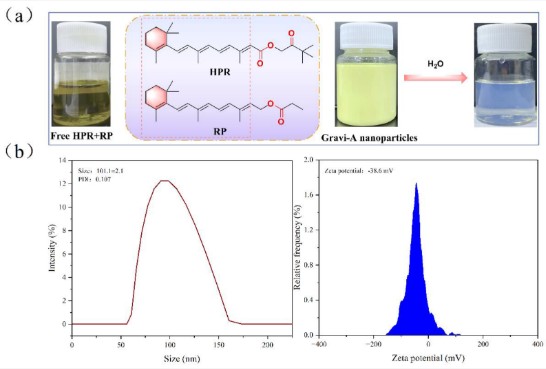
- About Us
- Products
- Hot Products
- Applications
- Services
- Supports
- Order Center
- Contact Us
 Xu, Huixian, et al. Journal of Dermatologic Science and Cosmetic Technology 1.4 (2024): 100046.
Xu, Huixian, et al. Journal of Dermatologic Science and Cosmetic Technology 1.4 (2024): 100046.
Hydroxypinacolone retinoate (HPR) is a potent anti-wrinkle agent, yet its cosmetic applications are hindered by severe irritancy, low stability, and poor water solubility. To overcome these limitations, an innovative approach utilizing ionic liquids (ILs) and nano-encapsulation has been developed to improve HPR's transdermal efficiency while reducing its adverse effects.
HPR-encapsulated ionic liquid nanoparticles (HPR IL-NPs) were formulated using an oil-in-water emulsion method combined with high-pressure homogenization. The resulting nanoparticles, with an average size of 92.8 nm, significantly enhanced the skin penetration of active compounds, increasing their concentration in the skin by 3.6-fold compared to traditional HPR-loaded creams. In vitro studies demonstrated a sustained release of HPR over 24 hours, ensuring prolonged efficacy.
Safety evaluations, including the chick chorioallantoic membrane assay (RC50 > 100%) and repeated skin irritation tests (mean irritation score of 0.00), confirmed the biocompatibility of HPR IL-NPs. A clinical trial further validated their effectiveness, showing a 25.09% reduction in wrinkle number and a 23.65% decrease in wrinkle area after just one week of application.
 Wang, Qianqian, et al. Journal of cosmetic dermatology 22.7 (2023): 2040-2049.
Wang, Qianqian, et al. Journal of cosmetic dermatology 22.7 (2023): 2040-2049.
Hydroxypinacolone retinoate (HPR) is a potent retinoid widely used in anti-aging skincare. This study explored the optimal ratio of HPR and retinyl propionate (RP) for dermal remodeling and skin aging prevention, demonstrating their synergistic effects in vitro and in vivo.
In human foreskin fibroblasts (HFF-1), co-administration of 5 μg/mL HPR and 9 μg/mL RP significantly increased cell viability by 40% after 24 hours, with negligible toxicity observed across all treatment groups. Gene expression analysis revealed that the combination therapy substantially upregulated collagen synthesis. At 48 hours, type I collagen (Col I) and type III collagen (Col III) mRNA levels increased by more than fourfold and 73%, respectively. At 72 hours, Col I expression remained 3.5-fold higher in the cotreatment group.
The co-administration of HPR and RP also synergistically enhanced the expression of type IV collagen (Col IV), cellular retinol-binding protein I (CRBP I), and retinoic acid receptor beta (RARB) over 72 hours. CRBP I expression increased up to 33-fold, while RARB expression reached a 5.7-fold enhancement at 72 hours.
These findings confirm that combining HPR with RP significantly improves collagen synthesis and retinoid receptor activation, establishing this formulation as an effective strategy for anti-aging applications in dermatology and cosmetics.
 Bai, De, et al. Pharmaceutics 15.3 (2023): 731.
Bai, De, et al. Pharmaceutics 15.3 (2023): 731.
Hydroxypinacolone retinoate (HPR), a next-generation retinoid, was successfully incorporated into Gravi-A nanoparticles using high-pressure homogenization. These nanoparticles, co-formulated with retinyl propionate (RP), exhibit superior stability and reduced irritation, making them highly effective for anti-wrinkle treatments.
The preparation of Gravi-A nanoparticles involved emulsification of HPR (3.0 wt%) and RP (5.4 wt%) within an oil phase consisting of caprylic/capric triglyceride, soybean lecithin, PEG-40 hydrogenated castor oil, and vitamin E acetate. This was subsequently combined with an aqueous phase containing glycerol, 2-pentanediol, 2-butanediol, edetate disodium, and purified water. The final microencapsulation step involved homogenization with sodium oleate under high pressure, ensuring enhanced delivery and prolonged stability.
A free HPR + RP formulation was also prepared for comparison, but the Gravi-A nanoparticle system demonstrated superior encapsulation efficiency, providing controlled release and reduced irritation potential. These advantages address common limitations of conventional retinoid formulations, such as instability and skin sensitivity.
The incorporation of HPR into Gravi-A nanoparticles represents a significant advancement in cosmetic dermatology, offering an optimized delivery system for enhanced skin rejuvenation. This study underscores HPR's potential in next-generation anti-aging formulations, reinforcing its role in dermal remodeling and wrinkle reduction.
What is the CAS number of Hydroxypinacolone retinoate?
The CAS number of Hydroxypinacolone retinoate is 893412-73-2.
What are some synonyms for Hydroxypinacolone retinoate?
Some synonyms for Hydroxypinacolone retinoate are Retinoic acid, 1-hydroxy-3,3-diemthyl-2-butanone ester, all-trans.
What is the molecular weight of Hydroxypinacolone retinoate?
The molecular weight of Hydroxypinacolone retinoate is 398.58.
What is the molecular formula of Hydroxypinacolone retinoate?
The molecular formula of Hydroxypinacolone retinoate is C26H38O3.
What is the predicted density of Hydroxypinacolone retinoate?
The predicted density of Hydroxypinacolone retinoate is 0.990±0.06 g/cm³.
What is the appearance of Hydroxypinacolone retinoate?
The appearance of Hydroxypinacolone retinoate is a colorless liquid.
What percentage of actives does Hydroxypinacolone retinoate contain?
Hydroxypinacolone retinoate contains 95% actives.
What is the physical state of Hydroxypinacolone retinoate?
The physical state of Hydroxypinacolone retinoate can be solid or liquid.
What are some typical applications of Hydroxypinacolone retinoate?
Hydroxypinacolone retinoate is used as an antioxidant.
What are the key properties of Hydroxypinacolone retinoate?
The key properties of Hydroxypinacolone retinoate include its molecular weight, predicted density, appearance, actives percentage, and physical state.